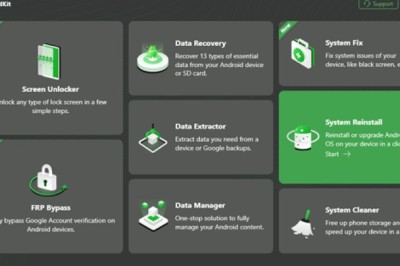views
The internet is filled with content. This space is getting more competitive.
Content marketing faces the biggest retention problem. How can you produce content that keeps your audience entertained? How to stand out in this competitive space?
This article will discuss the secrets to writing an effective content marketing strategy. Here, I will reveal 7 key elements of a successful content marketing strategy.
You can plan, produce, and tailor your content if you know these. And you will learn the art of producing content that speaks directly to your audience.
7-Step Strategy for Content Marketing
Regardless of your goal, here is a proven strategy to help you in your content marketing journey. Let's explore it.
1. Be Clear About Your Goal
How to set a clear goal for your content marketing strategy? Here you go:
● Assess your business objectives: Understand the broader goals of your business and how content marketing can contribute to them. Consider factors like brand awareness, lead generation, customer retention, or thought leadership.
● Define your target audience: Identify the specific audience segments you want to reach and engage with through your content. Understand their needs, preferences, and pain points to tailor your content accordingly.
● Determine key metrics: Choose measurable indicators that align with your goal. Examples include website traffic, conversion rates, email sign-ups, social media engagement, and content downloads.
● Set SMART goals: Make your goals Specific, Measurable, Attainable, Relevant, and Time-bound. This ensures clarity and provides a clear benchmark for success.
● Create a content roadmap: Develop a plan outlining the types of content, platforms, and channels you'll utilize to achieve your goals. Consider the frequency, formats, and distribution strategies.
● Monitor and analyze performance: Track your content's performance using analytics tools. Evaluate the metrics against your goals and make data-driven adjustments to optimize results.
2. Research Your Target Audience
There is no point in creating content that doesn’t speak to your audience. Here are the steps:
Begin by analyzing customer data, such as demographics, purchase history, and behavior patterns. This data can provide valuable insights into who your audience is and what they are interested in.
Engage directly with your audience through surveys or interviews to gather firsthand information. Ask open-ended questions to understand their needs, preferences, challenges, and aspirations.
Social media platforms are treasure troves of information about your target audience. Observe their discussions, comments, and interactions related to your industry or niche.
Utilize analytics tools to gather data on website traffic, engagement metrics, and search queries. These insights can help you identify popular content, keywords, and trends relevant to your target audience.
Analyze your competitors' content and engagement strategies. Look at the type of content they produce, their platforms, and the audience they attract. This can help you identify gaps, opportunities, and unique angles to differentiate your own content.
Participate in online communities and forums where your target audience congregates. Listen to their discussions, observe their questions, and take note of their pain points.
3. Content Audit
A content audit is like analyzing your strengths and weaknesses.
How to suit your existing content:
● Compile a comprehensive inventory of your content assets, including blog posts, videos, infographics, and social media posts.
● Assess each piece of content for its relevance to your target audience and alignment with your business goals.
● Determine if the content is accurate, up-to-date, and valuable to your audience.
● Use analytics tools to review key performance metrics like page views, engagement, and conversions.
● Identify high-performing content and areas for improvement.
● Identify topics or formats missing from your content portfolio but could resonate with your audience.
● Look for opportunities to repurpose or update existing content.
● Assess keyword usage, meta tags, and on-page optimization to ensure your content is discoverable.
● Based on your audit findings, create an action plan to optimize, repurpose, or create new content.
● Set clear goals and prioritize tasks to improve your content marketing strategy.
4. Competitor Analysis
Analyzing your competitors for content marketing insights is a valuable exercise.
● Identify competitors: Determine your main competitors in your industry or niche.
● Explore their content: Analyze their blog posts, videos, social media presence, and downloadable resources. Note their topics, formats, and engagement levels.
● Assess their audience: Look at their followers, comments, and interactions to understand their audience demographics and preferences.
● Identify gaps and unique angles: Identify content gaps your competitors haven't covered or find unique angles to differentiate your own content.
● Adapt and innovate: Use the insights gained to inform your content strategy, create compelling content, and offer a fresh perspective that sets you apart.
5. Knowledge of Content Management System
By immersing yourself in CMS knowledge and hands-on experience, you'll be well-equipped to leverage these platforms for effective content management and distribution.
● Research popular CMS platforms: Explore platforms like WordPress, Drupal, or Joomla, and learn about their features, capabilities, and user-friendliness.
● Take online courses or tutorials: Enroll in online courses or follow tutorials that provide step-by-step guidance on using CMS platforms effectively.
● Join online communities and forums: Engage with CMS communities to ask questions, seek advice, and learn from experienced users.
● Experiment and practice: Set up a test website or blog using a CMS platform and experiment with its functionalities. Practice uploading content, managing layouts, and optimizing for SEO.
● Stay updated: Follow CMS-related blogs, forums, and social media channels to stay informed about new features, updates, and best practices.
6. Researching and Finalizing The Topics
Start by analyzing the needs, interests, and pain points. What information would they find valuable or entertaining?
- Conduct keyword research: Use tools like Google Keyword Planner or SEMrush to identify relevant keywords and popular search queries in your industry.
- Explore trending topics: Stay updated on industry trends, news, and discussions to identify timely and engaging topics that resonate with your audience.
- Consider your expertise: Showcase your knowledge and expertise by selecting topics that align with your unique strengths and perspectives.
- Brainstorm and prioritize: Generate a list of potential topics and prioritize them based on relevance, audience demand, and alignment with your content goals.
7. Tracking and Analyzing Your Performance
Regularly track and analyze key metrics such as website traffic, search rankings, social media engagement, conversion rates, and user feedback. This helps you assess your content's impact and identify improvement areas.
Use the insights gained from analyzing your results to refine your content topics. Focus on those that generate positive outcomes and resonate with your audience.
Continuously reassess and adjust your content topics based on your audience's changing needs and preferences and the goals you set.
Bottomline
I hope that you get enough insights on this. Once you diligently follow this strategy, you receive many desired results.
Have you included all these elements in your content marketing strategy? Is there any other step that we missed?
Tell me in the comments.
























Comments
0 comment